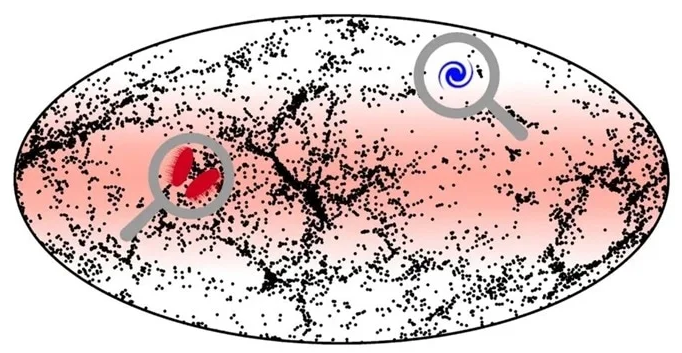The Milky Way galaxy is part of a significantly larger structure, the local Supercluster structure, which encompasses many enormous galaxy clusters and hundreds of individual galaxies. It is also known as the Supergalactic Plane due to its pancake-like form and size of about a billion light years.

In the supergalactic plane, which lies on the equator of the picture, galaxies experience frequent interactions and mergers, leading to the formation of massive elliptical galaxies. By contrast, galaxies away from the plane evolve in relative isolation, allowing them to preserve their disk-like structure. Image Credit: Till Sawala
The vast majority of galaxies in the cosmos fall into one of two categories: First, there are elliptical galaxies, which are largely old stars with extremely huge central black holes, and then there are actively star-forming disk galaxies, which have a spiral-like shape similar to the Milky Way’s.
Both types of galaxies can be found in the Local Supercluster; however, bright elliptical galaxies abound in the Supergalactic Plane, and brilliant disk galaxies are noticeably lacking.
A Cosmic Anomaly Challenges the Standard Model of Cosmology
This strange segregation of galaxies in the Local Universe, known since the 1960s, is prominently featured in a recent list of “cosmic anomalies” published by famous cosmologist and 2019 Nobel winner Jim Peebles.
A multinational team led by Till Sawala and Peter Johansson of the University of Helsinki appears to have identified an explanation. They explain how the differing distributions of elliptical and disk galaxies evolve naturally due to the varied conditions found inside and outside of the Supergalactic Plane in an article published in Nature Astronomy.
In the dense galaxy clusters that are found on the Supergalactic Plane, galaxies experience frequent interactions and mergers, which leads to the formation of ellipticals and the growth of supermassive black holes. By contrast, away from the plane, galaxies can evolve in relative isolation, which helps them preserve their spiral structure.
Till Sawala, University Researcher, Faculty of Science, University of Helsinki
The scientists used the SIBELIUS (Simulations Beyond the Local Universe) simulation in their work, which tracks the evolution of the universe spanning 13.8 billion years, from the early cosmos to the present. It was run on supercomputers in England and in Finland on CSC’s Mahti supercomputer.
The SIBELIUS simulation attempts to accurately replicate the observed structures, including the Local Supercluster, while most similar simulations take into account random regions of the cosmos that cannot be directly matched to observations. Surprisingly, the final simulation result matches the data.
Sawala added, “By chance, I was invited to a symposium in honor of Jim Peebles last December, where he presented the problem in his lecture. And I realized that we had already completed a simulation that might contain the answer. Our research shows that the known mechanisms of galaxy evolution also work in this unique cosmic environment.”
A huge statue depicting the distribution of galaxies in the Local Supercluster is located next to the physics department at the University of Helsinki's Kumpula campus. Carlos Frenk, a British cosmologist and one of the co-authors of this new study, inaugurated it twenty years ago.
The distribution of galaxies in the Local Supercluster is indeed remarkable. But it is not an anomaly: our result shows that our standard model of dark matter can produce the most remarkable structures in the universe.
Carlos Frenk, Study Co-Author and British Cosmologist
Journal Reference
Sawala, T., et al. (2023) Distinct distributions of elliptical and disk galaxies across the Local Supercluster as a ΛCDM prediction. Nature Astronomy. doi:10.1038/s41550-023-02130-6.